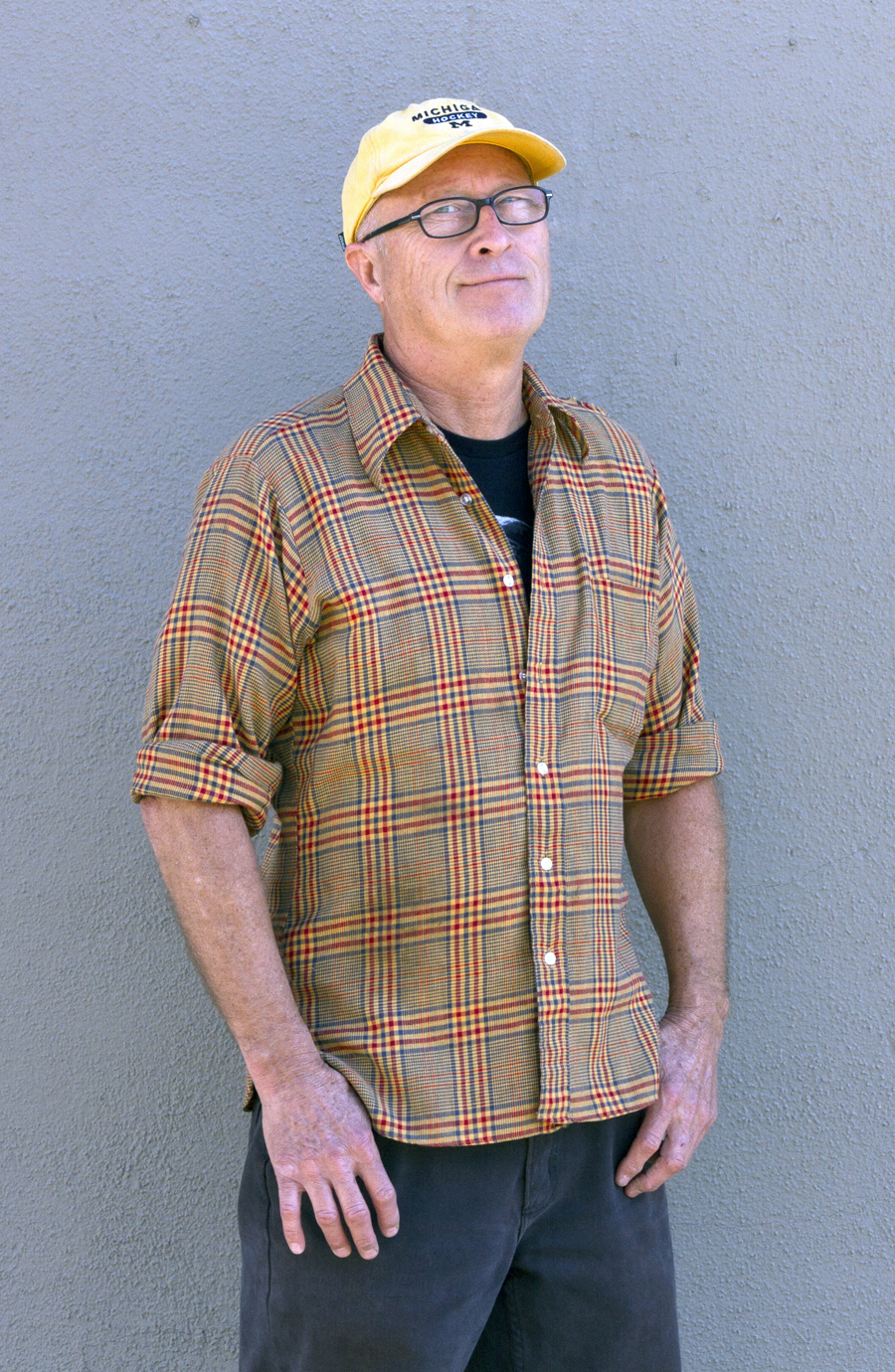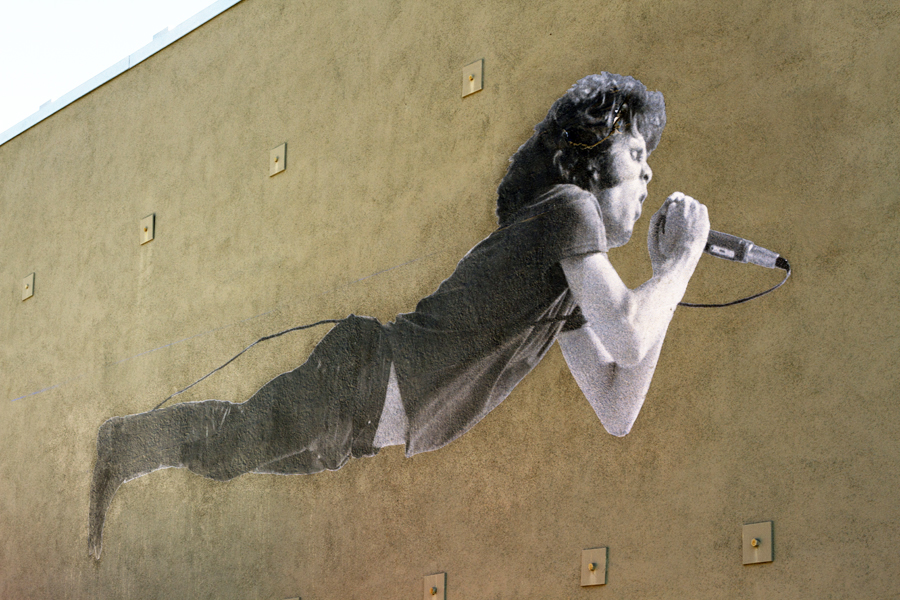
Jim Coke stands in front of Flying Morrison, a mural based on a photo he took of Jim Morrison. Photos by Hannah Maynard.
In the summer of 1967, classic rock was becoming not just an artistic force, but one that was forever connecting youth on a political and activist level that hasn’t been seen since.
It was during that summer, underneath the Southern Californian sun as it shone across Devonshire Downs in Northridge near noontime, that The Doors were taking to the plywood stage set up for the inaugural Fantasy Faire and Magic Music Festival. It was L.A.’s response to Monterey Pop and The Doors were following a performance by Kaleidoscope before Jefferson Airplane and headliner Canned Heat hit the stage. It was July and it was just two weeks before “Light My Fire” would take over the #1 spot on the Billboard Hot 100.
As Jim Morrison took the stage, Jim Coke—a Long Beach-bred student photographer shorthanded with just two rolls of film for the entire festival since he was, well, a student—knew he had to conserve his shots. It was a time, as Coke noted, where music was being created that would “make the next 45 years of music impossible to exist without.” Thus he scouted and roamed for the right show, eventually discovering the perfect location: a single, empty space on the stage that wasn’t filled with equipment or onlookers.
 Coke, normally hyper and quick to jump from one subject to another, becomes eerily focused when speaking of Morrison’s captivating presence.
Coke, normally hyper and quick to jump from one subject to another, becomes eerily focused when speaking of Morrison’s captivating presence.
“[All the bands] were just about the music… And I was limited in a lot of senses,” he says. “But when The Doors took the stage—and I saw [lead singer Jim] Morrison—it’s like he moved with the photographers.”
Subtly pointing to one of his shots currently hanging on the wall at Fingerprints (in it, Morrison stands near the edge of the stage, appearing to scream into the mic), Coke notes how the singer moved out of the way of a barricading microphone stand to make a more perfect shot for him. And this wasn’t just a one-time occurrence, but repeated, as Coke’s limited film roll was filled by a series of shots showing Morrison owning not just his vocal cords and the mic, but the world as well.
By 1969, Coke was feeling disconnected, leading him to ultimately sell all of his photography equipment to live life “off the beaten path” for over two decades before returning to Southern California—a journey he calmly notes he’s “not sure [he’s] ever really returned from.”
In the ’90s, Coke was not only reminded of his Northridge experience by Oliver Stone’s seminal biopic The Doors, but became introduced to new technology–the advent of Photoshop, which allowed him to create something he had been dreaming of creating.
“The first thing I thought of,” Coke says, “was this series of Morrison [screaming into the microphone] against an empty background and nothing else.”
The “Scream Sequence” then became a reality after Coke’s discovery: his snapshots of Morrison—largely due to Morrison’s model-like poses—sequentially animated Morrison as he howled a scream into his microphone. The result is a series of shots that not only captures a moment with a legend, but acts as a reminder of an entire era and ideology.
The result—the shot of Morrison cut out of his Devonshire Downs environment on a stage and pasted onto a blank background—was not as easy as one thinks. The first round of the “Scream Sequence” took two years, as pixel-by-pixel (literally: single pixel erasing) slowly unveiled the paper-cut-out effect Coke was looking for. Those two years then became three after Mary Werbelow—Morrison’s lover and the muse for Neil Young’s “Cynnamon Girl”—thought the first draft of digital images were not impressing.

As a result of this sequence and the progression of technology, Coke’s need to solidifying Morrison’s place in history as a “man of poetry, not just a man of the bottle” became heightened—leading to his most current endeavor: the Flying Morrison mural.
Using the empty space of the west wall of the building along Fontenac Court north of 4th St. (in what is now called Park(d) Plaza), Coke has wheat-pasted a 20-foot replica of the final “Scream Sequence” shot—Morrison, mic held high above his head as he almost tip-toes in his boots—arranged horizontally to give the illusion that the legendary singer is flying.
In honor of Morrison’s upcoming 70th birthday, the public is invited to not only view the street art mural dedicated to the legend right before he became solidified in American culture, but to also enjoy those who experienced the era of Morrison. Not only will Coke be there, but writer and self-described “audio journalist” Michael C. Ford—the man who performed poetry alongside Morrison—will speak, along with performing local bands Slushbox, Natural Hi-Fi, and MOVE.
Much like Coke’s own experience in ’67, it is sure to be an experience on 4th St. that will be as ephemeral as Morrison himself.
WAKE UP! a Jim Morrison photo/music/poetry event starts at 7PM at Fingerprints, 420 E. 4th St.
{FG_GEOMAP [33.7717091,-118.18703089999997] FG_GEOMAP}

